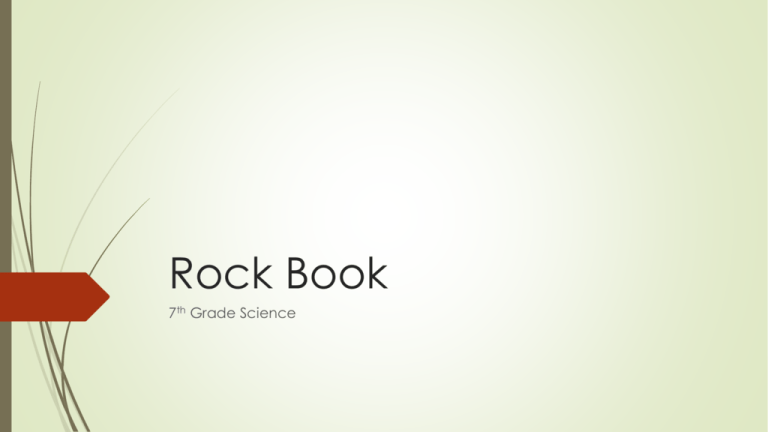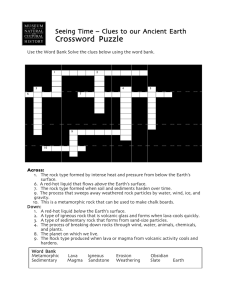Rock Book - Leon County Schools
advertisement

Rock Book 7th Grade Science Objectives: -Identify key vocabulary relating to the rock cycle. -Identify rocks as igneous, metamorphic and sedimentary. -Identify the process responsible for forming rock types Foldable (use 3 sheets of construction paper) Table of contents: (on inside cover) Sedimentary Rocks-page 1 Sedimentary Rock Lab-page 2 Metamorphic Rocks-page 3 Metamorphic Rock Lab-page 4 Igneous Rocks-page 5 Igneous Rock Lab-page 6 What are rocks? (write this on the front cover) Rocks are naturally occurring, solid mixtures composed of minerals, smaller rock fragments, organic matter or other grains. They are grouped by how they form. Watch Brain POP-Rock types Sedimentary Rock, pg. 1 Formed when sediment is pressed together by forces on or within the Earth to form rock 3 Types: detrital-grains of minerals or other rocks deposited in layers by water, ice, gravity or wind chemical-water loaded with minerals evaporates leaving behind the hardened minerals organic-material from once living things is pressed together to form rock Sedimentary Rock Lab, pg. 2 Conglomerate-detrital Sandstone-detrital Shale-detrital Siltstone-detrital Chert-siliceous/organic Arkose-detrital Limestone-carbonate Rock salt-chemical Rock Gypsum-chemical Travertine-chemical Oolitic Hematite-ironstone Coquina-organic Bitumous coal-organic Lignite-organic Clay-detrital DO: Divide your rocks into 4 groups based on their rock type: Detrital Organic Chemical Other Write a description of each group of sedimentary rock-what features/characteristics do each group have? Give 2 examples (rock names) of each group Metamorphic Rock, pg. 3 Metamorphic rock forms when existing rock is squeezed or heated (not melted)-usually old rock 2 types: Foliated-rocks have visible layers Non Foliated-no visible layers or banding Examples Metamorphic Rock Lab, pg. 4 Do: Divide your rock samples into 2 groups: foliated and nonfoliated. Metamorphic Rock Lab, pg. 4 Use the list to correct your groups: Foliated Nonfoliated 3) Augen gneiss 4) Biotite gneiss 1) Amphibolite 2) 2) Hornfels 6) Mica Schist 5) Garnet wollastonite skarn 13) Phyllite 14) Red slate 15) Grey slate 9) Marble 10) Quartzite 11) Serpentinite 12) Soapstone Metamorphic Rock Lab, pg. 4 Draw a picture to show and give 2 examples of each type of metamorphic rock: Foliated 2 examples: Nonfoliated 2 examples: Igneous Rock, pg. 5 Form from cooling of magma (inside the Earth) or lava (on the Earth’s surface) 2 Types: -Intrusive -Extrusive Draw a T-Chart with Intrusive and Extrusive as headings Igneous Rock, pg. 5 Intrusive Igneous Rock: -forms inside the earth -longer time required to cool because of hotter temperature-larger crystals -forms from magma Igneous Rock, pg. 5 Extrusive Igneous Rock -forms from lava on Earth’s surface -cooler temperature-faster cooling of rock-smaller crystals-can be glassy Igneous Rock Lab, pg. 6 Divide your samples in to 2 groups: Intrusive and Extrusive -how can you tell the difference? Igneous Rock Lab, pg. 6 check your groups: Intrusive Extrusive Diorite Gabbro Andesite Basalt Graphic Granite Granite Rhyolite Scoria Peridotite Monzonite Pumice Tuff Porphyry Obsidian Feldspar Porphyry Igneous Rock Lab, pg. 6 After regrouping your igneous rocks, Draw a picture to show the larger, coarse grains of an intrusive rock and the smaller grains of an extrusive rock (draw two pictures to show the texture) List 2 examples of Intrusive Igneous Rock List 2 examples of Extrusive Igneous Rock Review: On your index card, write down the groups for each rock type: Sedimentary: Name the 3 groups Metamorphic: Name the 2 groups: Igneous: Name the 2 groups: Rock Cycle, pg. 7 The Rock Cycle is a model that describes how different kinds of rock are related to each other and change from one type to another type. Rock Cycle, pg. 7 Processes in the Rock Cycle -compaction-pressing together of sediment by Earth forces -cementation-sticking together of sediment -weathering-breaking down of rocks -erosion-moving of sediment -heat from the Earth -pressure from the Earth -melting from a solid to liquid magma or lava Watch the Brain POP video and listen for these terms Rock Cycle, pg. 7 Draw a picture to show the rock cycle Which type of Rock? Which type of Rock? Which type of Rock? Complete your rock book By adding some rock pictures to it (at least 3) Can be photos printed or drawings Label each rock picture with the name of the rock and type of rock (Sedimentary, Metamorphic, Igneous) Make sure that you have all your notes and labs





